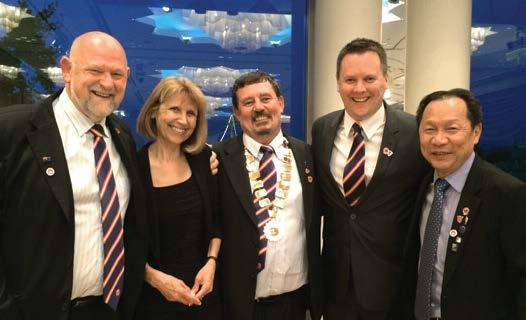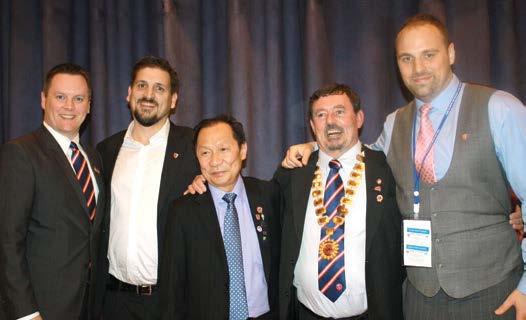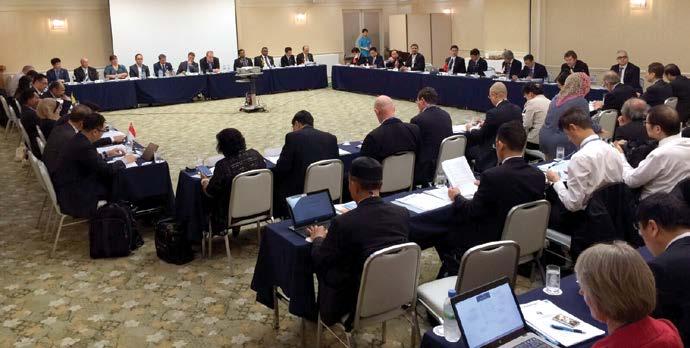
8 minute read
PAQS Congress recap
The 19th Pacific Association of Quantity Surveyors Congress May 29 – June 1, 2015 | Yokohama, Japan recap
The 19th Annual PAQS Congress was held in Yokohama, Japan at the end of May this year. Canada was well represented by Ian and Tyra Duncan, David Lai, Dave Burns and Matt Weber. The following is an overview and individual reports from the Congress.
OVERVIEW OF BOARD MEETING By Dave Burns, PQS(F)
During the 2015 PAQS Conference held in Yokahama, Japan, PAQS held its 19th Annual Board Meeting on May 30, 2015 with representation from its Member Organizations in attendance. In addition to Canada, professional bodies from Australia, Brunei, China, Hong Kong, Indonesia, Japan, Malaysia, New Zealand, Philippines, Singapore, Sri Lanka and South Africa were in attendance at the meeting. In addition, some observer organizations were present, including similarly-mandated, multi-national organizations such as the Conseil European Des Economistes de la construction (CEEC) and the International Cost Engineering Council (ICEC). Representing Canada at the meeting were Dave Burns, CIQS Chair and David Lai, CIQS Education Director. This Conference was the last meeting to be chaired by the outgoing Chair from China, Ms. Xu Huiqin, who was completing her last term in the Chair.
During the meeting, standard organizational business was conducted such as the review of past meeting minutes and the reading of prepared reports inclusive of the Chairman’s Report, Secretary’s Report, Treasurer’s Report, PAQS Iwata Foundation Report and the Council of Advisors Report. In addition, standard PAQS items such as award recipient details, essay competition winners, website updates and individual member country reports were also discussed.
Within the organization, a number of specially-formed committees, which focus on commonly shared member themes, had prepared individual reports for presentation. Accordingly, the Education Committee, Research Committee, Sustainability Committee, and the Young QS Group presented their report findings and recommendations, from which mandates and objectives were further developed.
Towards the end of the Board Meeting, PAQS held its Election of PAQS Officers for the 2015-2017 term. This segment of the meeting was particularly exciting for the CIQS, as one of our designation holders and a Past CIQS President, Ian Duncan, PQS was elected to sit as new the Chairman for PAQS. Effectively, Ian will Chair the next PAQS Conference in Christ Church, New Zealand in 2016 and in Vancouver, BC in 2017.
In traditional form, the 19th Annual PAQS Board Meeting closed with gift exchanges and a Board Photo session with all attendees.
During the PAQS Conference, the CIQS participated in the Sustainability Committee Meeting discussions through Dave Burns, PQS who represented Canada. This committee was recently established as one of the newer working groups and was chaired by Michael Manikas, of the AIQS (Australia). During the meeting, discussions led primarily to developing the mandates of the group as relating to efficiencies in construction, the reduction of energy consumption, the relationships between carbon footprints and construction and sustainability in general.Interestingly, it transpired during committee discussions amongst the various group members that a common means of assessing building efficiencies achieved on a project is difficult (if not impossible) to discuss, simply because a common measuring standard (for energy savings /building efficiency) among the various countries is not in place. Different countries utilize different systems, with different benchmarks and with different rating systems, to conduct their reporting. For instance, efficiency achievement standards were measured in a variety of methods such as through utilizing LEEDS (Gold, Silver, Platinum), an R-Rating system (R-20, R-30, etc.), a Star Rating System (1 Star–5 Star,) or perhaps using a Number Rating System (1–10). All of the discussed measurement


standards are commonly recognized systems which within their countries of origin, but they vary dramatically depending on the country in which you operate, and are difficult to compare without a legend or common denominator.
Accordingly, through meeting conversations, it was decided that the first deliverable would be to assemble and organize information from each of the participating member countries which detailed the rating systems in place, the local measurement practices employed and the authority or organizational bodies which oversaw each. In some countries, government bodies manage these measurement practices, whilst in other places, non-profit organizations oversee building efficiency measurement standards. Through the development of a Committee Report which presented this information, further mandates could be developed. The committee chair is currently developing a standard questionnaire for all Sustainability Committee participants for input towards this undertaking.
RESEARCH COMMITTEE REPORT By Matthew K. Weber, PQS
Matthew K. Weber, PQS attended the PAQS 2015 Research Committee on Thursday, May 28, 2015 and represented CIQS. Mr. Weber observed that the research committee was going through a shift of structure and intent. During the meeting, each member country shared their research completed over the past year which mostly centered around education, sustainability and BIM which are all other PAQS committees. During the meeting, it was agreed that the committee chair would provide a mission statement, goals and expectations of the committee so that at the next board meeting each member country could come with more items to discuss. There was also a long discussion about continuity on the committee, as over 60% of the attendees were new to the committee, including Mr. Weber. It was agreed that each member country would need to appoint a successor within a month of the PAQS meeting so the successor could be included on email correspondence from the committee. The committee agreed that further information would be shared by email and to continue to future research the profession in their member country between now and the next PAQS event.
BIM COMMITTEE REPORT By Mark Russell, PQS(F)
The 2nd meeting of the BIM Committee was held in Room 801 in the Yokohama Symposium with no working air conditioning. Given that the temperature outside was 27 degrees and muggy, this proved a little challenging; however, paper fans were made available to assist the representatives in moving the warm air around.
Most of the member countries had representatives in attendance, although the Chair could not make the meeting. It appears that the Chair has not been present for any of the BIM meetings, which is disappointing and would appear to not bode well for the running of the meeting. However, these fears were unfounded as the representative from Singapore stepped in to Chair the meeting and we got down to business.
The meeting started off with a ‘round the table’ open discussion on an update on how BIM measurement and adoption in your country is being implemented. This proved to be very engaging and allowed for a free flow of discussion.
Australia commenced the discussion and informed the Committee that BIM is being widely used, however, most design firms are now using it as a presentation tool more than anything. Models are being put together in a skeleton fashion in a show of style over substance. The representative stated that his firm has invested a great deal of time working with select design firms, in order to work the model to suit how the Australian MoM is set up. This has produced great results and has cut down takeoff times on these projects significantly, with no loss of accuracy or misallocation of quantities. The BIM results with other firms had less of an impact and took as much time to produce a Cost Plan as a standard 2D electronic takeoff.
New Zealand added that they found BIM to be a useful tool for clash detection for the Construction Managers and issued a copy of the New Zealand Government’s Best Practices Guideline for BIM.
China stated that BIM is being used on most projects and they intend to increase this usage in the upcoming year. Hong Kong also noted that BIM is part of a typical project, but cited concerns about the tie in with their MoM.
The real star of the show was the host nation, Japan, and their software program called ‘Helios’ which is seamlessly integrated with the BIM systems in the market and works wholly in conjunction with their MoM. The Japanese representative and their observers carried out a demonstration of how the system works and the results were truly impressive. The QS has the ability to ‘add’ design elements to the model, in order to show the design team what their intent is in quantifying the project. This allows the design team to see the assumptions

that are made and comment accordingly. The beauty of the system is that it knows where the limits and parameters are for the particular MoM element and snaps to the correct line/grid. Requests by some of the other country representative to translate the system into English were politely declined!
The meeting concluded with Australia, New Zealand, Canada and Hong Kong loading their presentations for use by the stand in Chair for the purpose of the minutes.
There appears to be a good appetite for this fledgling Committee and I would expect to see further advances by the time of the next meeting in Christchurch next year.
ACCREDITATION AND EDUCATION COMMITTEE REPORT By David Lai, PQS(F)
The 13th meeting of the PAQS Accreditation & Education Committee was held on Friday, May 29, 2015 in Yokohama, Japan. Attending the meeting were delegates from Australia, Brunei, Canada, China, Fiji, Hong Kong, Indonesia, Japan, Malaysia, New Zealand, Philippines, Singapore and Sri Lanka.
Three main issues were discussed during the meeting: 1. The accreditation report for the
University of Moratuwa, Sri Lanka which was presented to the committee. After reviewing the report the committee approved the accreditation of the Bachelor of
Science in Quantity Surveying program offered by the university. 2. The outline of a Graduate Diploma in
Technology (Quantity Surveying) to be offered by Massey University was presented by the representative from
New Zealand. After much discussion it was agreed that the committee would review any accreditation application made regarding this program in the future. 3. The promotion and assistance in the development of the QS profession in Philippines and Indonesia was discussed and it was agreed that representatives from Malaysia would assist in this venture.
PRESENTED BY




